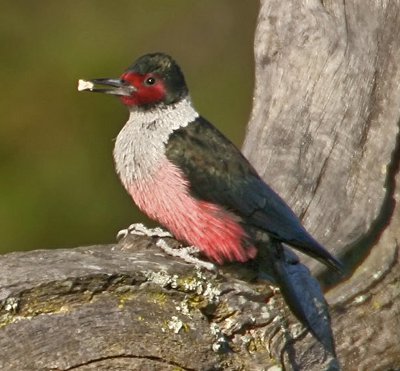Lewis Woodpecker
Category: Woodpeckers

Facts about Lewis's Woodpeckers, "Scientific name for Lewis's Woodpecker is "Melanerpes lewis". Lewis's woodpecker is a Melanerpes type of woodpecker that comes from the Picidae family. "Scientific name for Woodpecker Picidae". Lewis's Woodpeckers are birds in the Class of "Aves".
The Lewis's Woodpecker are native to North America, and are one of the biggest woodpeckers in America. The Lewis's Woodpeckers are locally widespread, lodging generally in open pine forests, and other regions with scattered snags and trees. The Lewis's woodpecker is different from other woodpeckers of America, and it takes pleasure in sitting in the open rather than sitting in the profound tree cover. The Lewis's Woodpecker mostly ranges in the western region of the central part of the United States, but during the winter season, the Lewis's Woodpecker move to the southern Mexican border of the United States and during summer they move to the northern parts of Canada. The Lewis's Woodpecker can be seen in three Midwestern states, such as Wisconsin, Michigan and Minnesota.
Features
The Lewis's woodpecker is a big-sized woodpecker, with a body length, ranging from 10 13/64 inches to 11 inches (25.9 to 27.9 cm), with the wingspan that ranges from 19 19/64 inches to 20 1/2 inches (49 to 52 cm). They have a body mass that ranges from 3.1 pounds to 4.9 pounds (1.4 to 2.22 kg).
Lewis's Woodpeckers have zygodactyl feet, having 4 fingers, which means they have two toes facing the front and two toes facing the back, that helps them to have a strong grip on trees vertically. The Lewis's Woodpecker use these 8 fingers with their stiff central portion tail feathers to brace on trees as they climb.
When feeding, drumming and building a nest cavity, a Lewis's Woodpecker can peck up to 20 times per second, wow that's fast! or a total between 9,000 and 12,000 pecks in a day.
The Lewis's woodpecker has a blackish-green color body, with red color breast, with a black color rump. The Lewis's Woodpecker has a gray color collar and upper breast, with a pink color stomach, and a red color face. The wings of the Lewis's Woodpecker are broader than those that of other varieties of woodpeckers, and it flies at a more lethargic speed with slow, but even flaps its wings like the wings of a crow.
The Lewis's Woodpecker seldom digs wood for boring pests, but it collects insects from the surface of the tree, or more generally, catches the flies. The Lewis's Woodpecker spends a longer time in observing flying insects from the top of a dead tree or a pole, and then flies out to grab them in flight
The Lewis's Woodpecker mated duo digs a hole in a rotten tree, usually a Ponderosa pine or cottonwood. The nest hole is wizened with wood-chips and they habitually use the nest sites again.
Diet
The summer and winter diet of Lewis's Woodpecker is flying insects. However, during fall and winter they feed mostly on fruits, acorns, seeds, and nuts.
There are more than 190 species of woodpeckers worldwide, but none of them are found in polar regions, Madagascar, New Zealand or Australia.
Male and female Lewis's Woodpeckers are able to drum hollow trees logs execrate.The Sounds and exhibitions used for mating courtship include churr call, chatter call and drumming, wings-out display, and circle flight display. They also use some of these practices on protecting there territory.
An average Woodpeckers tongue is up to 4 inches (10.16 cm) long. The length can be a little different depending on which species of woodpecker. Its tongue wraps around the reinforced skull structured and squashy bone, to even out the impact of the pecking force. Lewis's Woodpeckers have barbed tongues that helps them remove bugs from holes and tree bark.
Feathers that look like hairs on the Lewis's Woodpecker nostrils, prevent ingestion of wood particles.
Lewis's Woodpeckers have a prominent surge in flight comprise of three rapid wing flaps, followed by a quick glide when the Lewis's Woodpeckers wings are tucked against its body rather than spread out like many other birds.
The average life span of a Lewis's Woodpecker in the wild is 4 to 11 years, depending on the species and environment
Woodpeckers are omnivores; meaning - an animal that eats food of both animal and plant and origin.
Woodpeckers are monogamous meaning- the pair will mate for lifetime. Both male and female prepare the nest in the tree for babies and both will help feed them. The female will lay between 3 and 5 eggs and the incubation period will lasts 11 to 14 days. After one month of hatching, young woodpeckers will leave the nest and venture out on there own.
Woodpeckers possess a protective ocular mechanisms for protecting its eyes from shaking from the pecking impact. woodpeckers show a restricted axial globe movement due to the tight fit within the fascial tissue connections and orbit between the sclera and orbital rim.
The eyes of the woodpecker are covered with a nictitating membrane (from Latin nictare, to blink)— a translucent and transparent third eyelid - that protects the woodpeckers eyes from flying debris while pecking.

 Back To Category Woodpeckers
Back To Category Woodpeckers